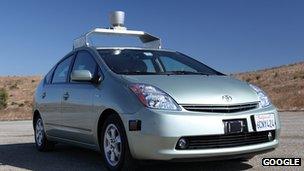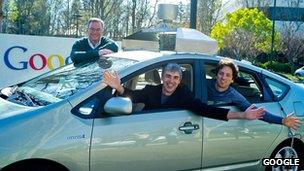Driverless car: Google awarded US patent for technology
- Published

Google has been experimenting with driverless Toyota Prius cars in the US
A US patent for self-driving cars has been awarded to Google.
The intellectual property rights relate to a method to switch a vehicle from a human-controlled mode into the state where it takes charge of the wheel.
It explains how the car would know when to take control, where it is located and which direction to drive in.
The search firm suggests the technology could be used to offer tours of tourist locations or to send faulty models to repair shops.
The application forTransitioning a Mixed-mode Vehicle to Autonomous Mode, externalwas applied for in May, but had been hidden from public view until this week.
The document describes using two sets of sensors. The first identifies a "landing strip" when the vehicle stops. This then triggers the second set which receives data informing the machine where it is positioned and where it should go.
"The landing strip allows a human driving the vehicle to know acceptable parking places for the vehicle," the patent filing says.
"Additionally, the landing strip may indicate to the vehicle that it is parked in a region where it may transition into autonomous mode."
Direct and drive
Google says the landing strip could simply be a mark on the ground, a sign on a wall, or lines or arrows showing where the vehicle should be parked.
To detect which landing strip it has been parked at, the document says the car could activate a GPS (global positioning system) receiver to find its rough location and then use its sensors to detect trees, foliage or other known landmarks to determine its exact position.
Alternatively the filing says the car could read a QR code - the popular two-dimensional square barcode - which would have details about the landing strip's location.
Telling the car precisely where it has been parked could be crucial to ensuring it knows where to go.
The patent explains that GPS receivers are sometimes only accurate to about 30ft (9.1m). However, if the vehicle can monitor its path and knows where it started from, it can simply be told to drive set distances from that point, adjusting its direction at the appropriate places.
The patent describes how data provided at the landing strip could also tell the vehicle to look up an internet address which would let it know if it needed to drive itself to a repair shop, or simply move to another parking bay to ensure a hire company had its cars spread evenly across its various pick-up spots.
It says the landing strip could also provide information about how long the vehicle should pause before driving off.
"The wait period may enable a human who was driving the vehicle to exit the vehicle and remove his possessions," the filing says.
"Additionally, the vehicle may be equipped with additional sensors that enable it to detect when the human has moved a sufficient distance away from the vehicle to allow safe autonomous operation."
Google adds that the driver may not always wish to leave the vehicle after it has switched into automatic mode.
It gives the example of a self-drive vehicle providing a tour of Chicago's Millennium Park with the machine programmed to stop at the site's ice rink, fountain and sculptures for set amounts of time before returning to its starting point.
Patent experts note that Google's patent will not prevent others developing rival self-drive vehicles.
"This patent, which is effective in the US only, would only be enforceable to prevent other companies from using the same specific method and not to prevent other companies also providing autonomous vehicles in general," said Andrew Alton, a patent attorney at Urquhart-Dykes & Lord.
Test runs
Although the technology described may sound fanciful, Google has been testing a fleet of driverless cars for several years. The vehicles combine artificial intelligence with the firm's Google Street View maps as well as video cameras and a range of sensors.

Experts say Google's "passion project" could end up creating a valuable revenue stream
It has adapted a fleet of Toyota Prius and Audi TT models which have driven 160,000 miles with limited human input and more than 1,000 miles without driver involvement.
The cars travelled along Highway 1 between Los Angeles and San Francisco, over the Golden Gate Bridge and elsewhere. Two humans were on board at the time - one to oversee the driving and intervene if necessary, the other to monitor the equipment from the passenger seat.
The firm has also successfully lobbied the state of Nevada to pass a law requiring its Department of Transportation to create rules and regulations for autonomous vehicles on its highways.
Engineers behind the project say that robots can react more quickly than humans, meaning the number of road accidents could be reduced. That might also mean more cars could be on the road at the same time, driving closer together thus increasing road capacity.
Google told the BBC it had no further comment to make on the project at this time.
The patent will allow Google to restrict other companies from using a similar method to switch their cars between human-controlled and automatic modes. Alternatively it could charge them a fee for a licence.
Experts say driverless cars could become a commercial prospect sooner than most people believe.
"Google believe it is a technology that is here and now and will start appearing in motorcars in the near future," said Professor Alan Woodward from the department of computing at the University of Surrey.
"We already have systems that park your cars for you and automatically brake - the next obvious step is to have cars take over the routine driving.
"Google has funded a lot of this work at universities. Not surprisingly, if they think it is going to be big they want to patent it."
- Published10 October 2011
- Published10 October 2010